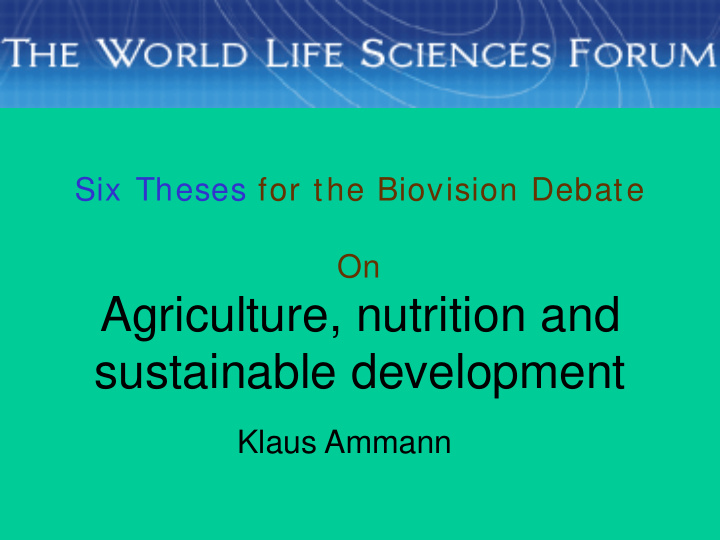



Six Theses for the Biovision Debate On Agriculture, nutrition and sustainable development Klaus Ammann
Perceived through science Virtual Perceived risk directly (hypothesis) Adams 1994, amended We live in a risk minded society; see Adams, J. (1994) Risk Ucl Pr Ltd (August 1, 1995), IS: 1857280679, pp 228
Distorted Risk Perception I
Distorted Risk Perception II
Precautionary Approach: the original wording in the protocols Term coined at Rio 1992 Convention of the Biological Diversity Term based on REAL negative data, trends difficult to project into the future
Precautionary Approach: In the Biosafety Protocol: Term in its concept has changed fundamentally: Now based on mainly unknown risks difficult to project into the future
Risk = Hazard / Chance Widespread definition, but onetrack-minded Risk = Hazard x Likelyhood 2 Or worse: Risk = Social bla bla x (media frenzy) Ammann, K. (2004) The Role of Science in the Application of the Precautionary Approach,. In Molecular Farming, Plant-made Pharmaceuticals and Technical Proteins (eds R. Fischer & S. Schillberg), Vol. 1, pp. 291-302. Wiley-VCH Verlag GmbH & Co. KGaA, Weinheim, http://www.botanischergarten.ch/Precautionary/Ammann-Precautionary-Approach1.pdf
The Familiarity Approach needs some more precise definition: 1. Regional differentiation 2. Monitoring basic research 3. Differentiation according to new traits http://www.agbios.com/cstudies.php?book=BIOSAFETY&ev=RISKANALYSIS&chapter=Ch-2 http://www.biotech-info.net/regulating_biotech.html The OECD Familiarity Approach http://www.botanischergarten.ch/OECD/ScaleupCropPlants.pdf or http://www.oecd.org/searchResult/0,2665,en_2649_37437_1_1_1_1_37437,00.html
Proposal: Article 14: 1. Parties may enter into bilateral and multilateral agreements and arrangements regarding international transboundary movements of LMOs, consistent with the objective of this Protocol and provided that such agreements and arrangements This is where the Familiarity Approach could be introduced in new interpretations: Example: Bt strategy in crops : hundreds of high quality papers have shown that there are no major problems left to be solved. Even toxicological studies in the lab have shown that the effects many non-target insects are minor (example of the lacewings) Romeis et al. 2004. Candolfi et al. 2004: Baseline comparison shows clear benefits of Bt-crops over pesticide spraying
Candolfi, M.P., Brown, K., Grimm, C., Reber, B., & Schmidli, H. (2004) A faunistic approach to assess potential side-effects of genetically modified Bt-corn on non-target arthropods under field conditions. Biocontrol Science and Technology, 14, 2, pp 129-170 http://www.botanischergarten.ch/Bt/Candolfi-Biocontrol-2004.pdf Orius, Wirkung von Karate (Pestizid)
Romeis, J., Dutton, A., & Bigler, F. (2004) Bacillus thuringiensis toxin (Cry1Ab) has no direct effect on larvae of the green lacewing Chrysoperla carnea (Stephens) (Neuroptera: Chrysopidae). Journal of Insect Physiology, 50, 2-3, pp 175-183 http://www.botanischergarten.ch/Bt/Romeis-et-al-04-Chrysoperla.pdf and evaluation F1000: http://www.facultyof1000.com/article/15019519/evaluation See also the overall report on the impact of agricultural biotechnology on biodiversity: Ammann, K. (2004) , Electronic Source: the impact of agricultural biotechnology on biodiversity, a review, published by: Klaus Ammann, accessed: 2004 http://www.botanischergarten.ch/Biotech-Biodiv/Report-Biodiv-Biotech12.pdf Titel der Arbeit von Romeis et al.
Romeis et al. 2004 Vergleichs-Resultate der Fütterungsstude v. Romeis
Ammann, K. & Papazova Ammann, B. (2004) Factors Influencing Public Policy Development in Agricultural Biotechnology. In RISK ASSESSMENT OF TRANSGENIC CROPS. (ed S. Shantaram), Vol. 9, pp. 1552. Wiley and Sons, Hoboken, NJ, USA. In: P. Christou & H. Klee: Handbook of Plant Biotechnology, http://www.botanischergarten.ch/Wiley/Factors-Discourse-Wiley.pdf
Scientists for Labour Organic Farming Appendix 1 http://easyweb.easynet.co.uk/~sfl/scienceagric/Index.html
high tech and organic Figure 1. A diagrammatic indication of the relationship between economic development and environmental concern. The three primary economic systems of agrarian-, industrial-, and knowledge-based service are indicated with arbitrary indications of wealth and development. SO 2 emission is used merely as an indicator of industrial development and the subsequent environmental concern generated The Population/Biodiversity Paradox. Agricultural Efficiency to Save Wilderness Anthony J. Trewavas Plant Physiology Jan. 2001
What is the contribution to Golden Rice 2 Percent of Recommended Nutrient Intake (WHO/FAO) Nutrient Intake? 200% SGR2 150% (Golden Rice 2 Non-staple 100% plant Animal and Fish 50% 0% Latest figures Adult Women Children 4. 2005 from HarvestPlus
Swaminathan‘s view on tackling with the problems of poverty a highly complex system
What are the Millennium Development Goals? The Millennium Development Goals are the world’s time-bound and quanti-fied targets for addressing extreme poverty in its many dimensions— Income poverty, hunger, disease, lack of adequate shelter, and exclusion— while promoting gender equality, education, and environmental sustainability. They are also basic human rights—the rights of each person on the planet to health, education, shelter, and security as pledged in the Universal Declaration of Human Rights and the UN Millennium Declaration.
Amish farmers in biotech-debate: subsequent partial adoption of transgenic crops: 1999, see: http://www.ifpri.org/2020conference/PDF/summary_ammann.pdf
Foto Claus Lange, Text Michael Miersch Weltwoche 06 2003 armer de Jonghe in Holland, produces organic andard vegetables without pesticides
Time needed for Bobwhite Quail Chicks to Satisfy Daily Inect Requirements (Fawcett & Towery, 2002)
http://www.genepeace.ch/ Demonstration of Swiss Researchers
Not this kind of future, PLEASE !
Recommend
More recommend